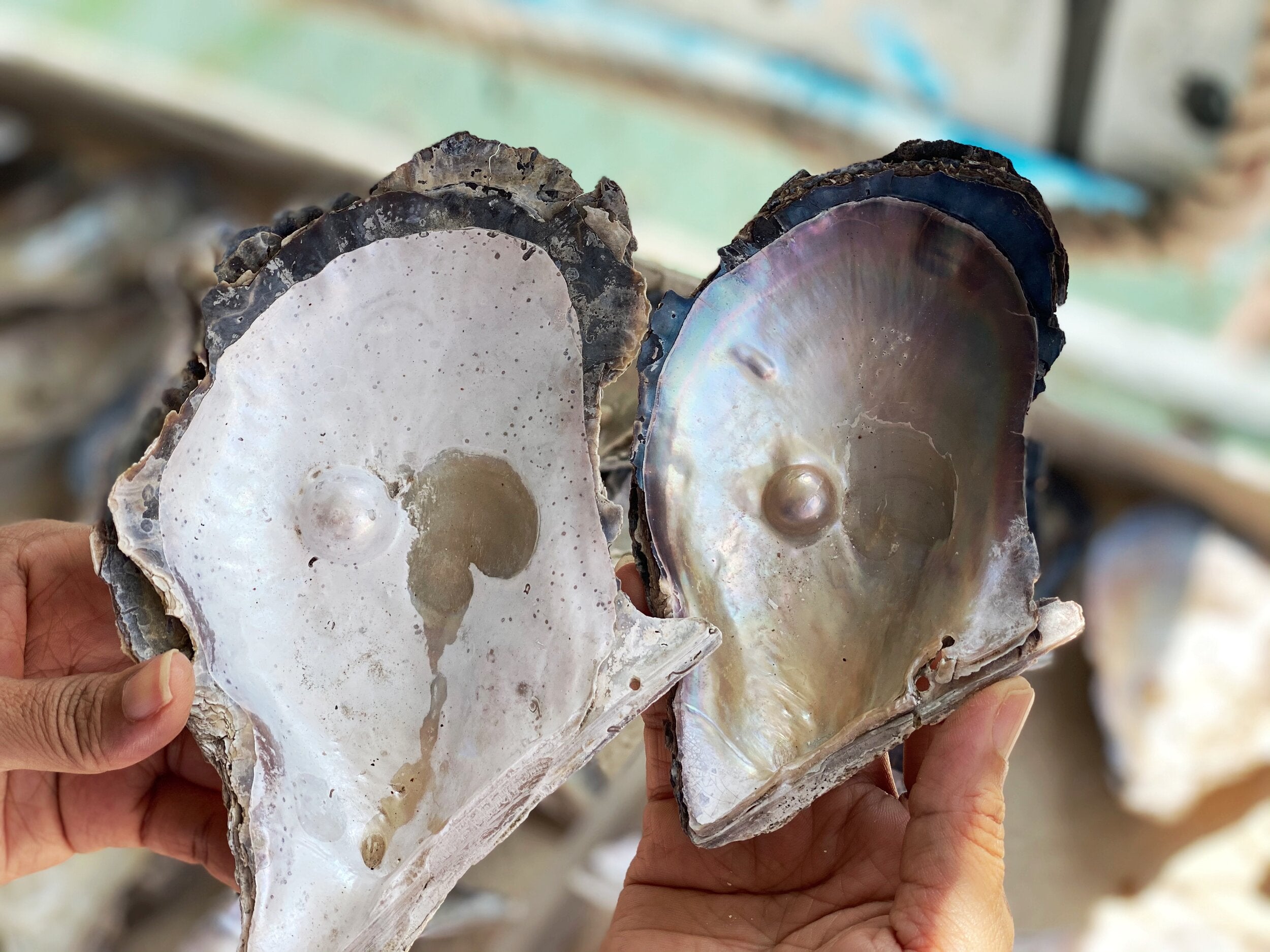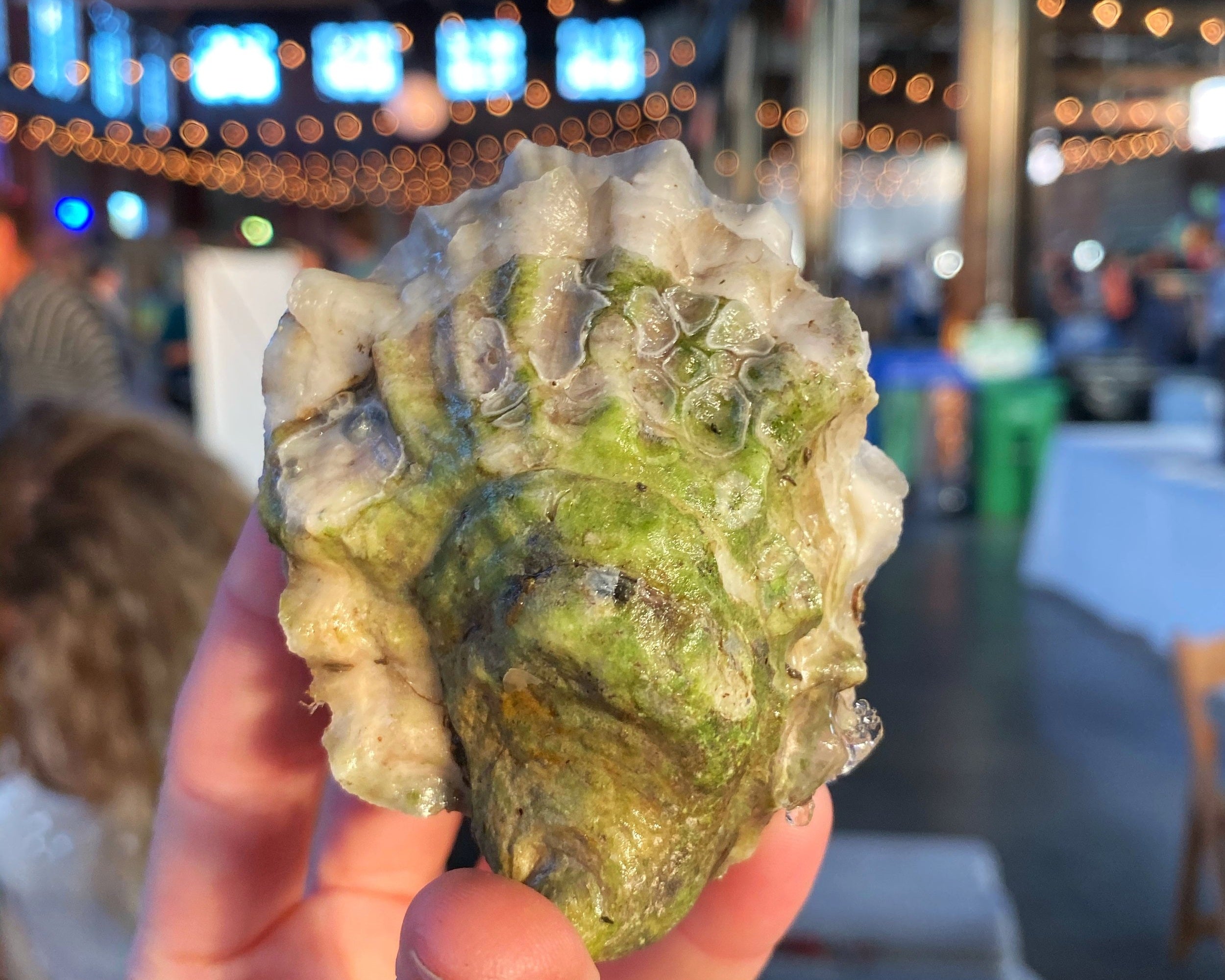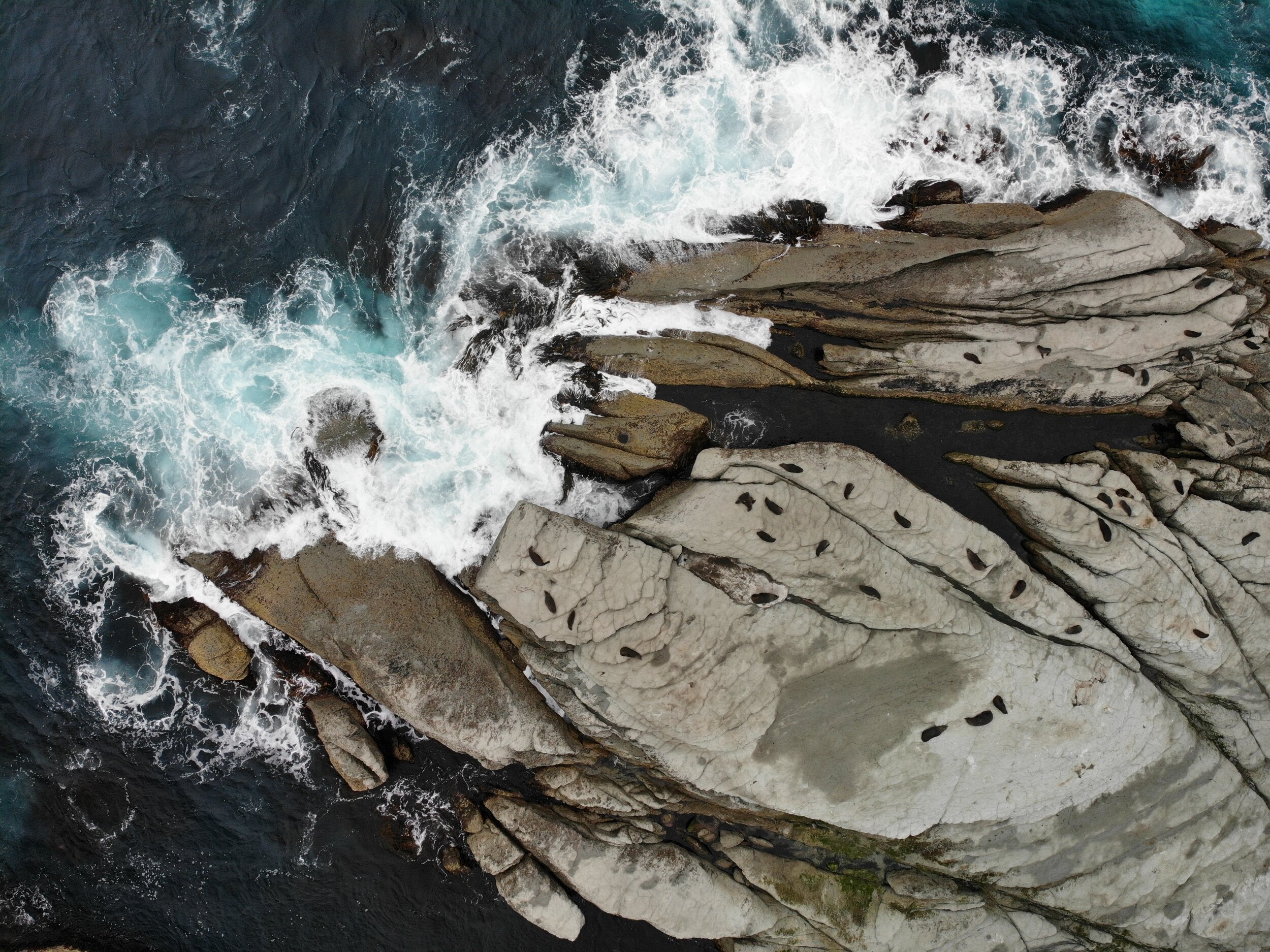The Lustrous Life of Pearls: Thailand’s World Inside the Oyster

Thailand, one of the most beautiful countries in the world, is a rainbow land, generous with delicious culinary flavors, warm people, and glittering shorelines.
I have been to Thailand about five times and first the first time this year, made it to Phuket for a business trip, which is a very popular tourist destination - in part for its white beaches, nightlife, and surrounding archipelago.
It is also home to farming a gem that the world has long admired for thousands of years: pearls.
Thai pearls are well-known in the global marketplace, and with this opportunity I took to online research on what I could do to explore the industry and their practices. Like my curiosity for halfshell, it’s about time I learned the process for one of my most favorite adornments.
Below is my experience at Phuket Pearl, Phuket’s only pearl farm. They’re a family-owned operation and have been farming oysters for almost 50 years. It was a brand new world to me but to my surprise, a lot of the elements of farming oysters were the same. Similar to the craftsmanship of a well-farmed oyster in the US, each oyster at Phuket Pearl is treated with utmost care, and given a lot of TLC for the special role they play.
Enjoy the story!

Overlooking the Phuket Pearl farm.
Organizing the tour.
Thanks to Amanpuri, one of the most incredible resorts in Phuket, I was able to curate a solo experience to visit Phuket Pearl. I engaged with our hotel because I hesitated in my own research. There had been some online discussions on pearl farm tours being a fake door to pearl sales. Most people label a pearl farm tour as a tourist trap because they invite you to their pearl showcase afterwards.
This is actually far from the case. If you’re a savvy traveler and interested in pearls, you should be encouraged that a business provides you the genuine, transparent opportunity to see into their practices. Moreover, you pay about US$50 for the tour, rather than being given a free charade in hopes you purchase something in the end. Having this experience more closely connects you to the product and for many gem aficionados, sourcing is a huge deal. So, let’s settle this tourist debate once and for all – take the tour, enjoy the education, and buy the pearls or don’t. The experience is fascinating.

I was picked up from my resort around 9AM in the morning, which was offered as a part of the experience. After about 30 minutes, we took a turn off one of Phuket’s main arteries and down a windy path with lush vegetation until we reached the docks.
Access to the farm required a short boat ride offshore, which offered a little wind in the dead of heat. The landscape and coastline of the inlet felt a lot more local than I had imagined. Here, you caught glimpses of fisherman boats, local restaurant shacks along the water, and the hilly islands off in the distance. It offered an alternative perspective to the neatly combed beaches of the resorts.

Arriving to Phuket Pearl’s farm by boat. This is where i was greeted by Phet.
Meeting Phet
Upon arrival to their large floating docks, I was greeted by my favorite person of the day, Phet. She was wearing a blue sweatshirt, pants, gloves and a hat, and totally amazed me by her energy and lack of sweat in 95-degree weather. She laughed often and didn’t hesitate to tell me she thought I was pretty, which had me blushing hard.

Phet showing me around the farm.
The floating docks were covered by roofs in two major areas – where they were growing their homemade algae and assembling equipment, and another area for the actual pearl engineering team who were entrusted with the task of inserting the pearl nuclei into the oysters. Overall, the entire operation didn’t extend more than about an acre. To think how many pearls come out of this single operation was unbelievable.
In the entrance area, my eyes gravitated towards a massive heap of oyster shell, piled and dried. It was the excess shell that was going to be packaged and used for mother of pearl products. Noticing my amusement, Phet made sure to share that nearly every part of the oyster was used for something, and not wasted.

Phuket Pearl employees hard at work in creating the metal spokes for which they tie the oysters.
Phet’s education session
Before touring the farm itself, Phet guided me to a small picnic table on the platform to review the various oyster species they grow on the farm. Lined up in a row were samples of both the oysters and the pearls they create. It was a vivid and tangible display where she let me touch the oysters - even open one up that was ready for extraction, and feel the difference in the pearl qualities.

The array of pearl discovery.

The “Golden Wing” oysters produce Mabe pearls.
Phuket Pearl cultures the Akoya pearl, the South Sea pearl, and Mabe pearl. Here are the differences.
Mabe Pearls
Mabe pearls are developed in what’s referred to as the “The Gold Winged” or “Penguin’s Wing” oyster (officially called Pteria Penquin), which are native locally to the Andaman Sea. The “wing” reference is obvious when you see the shape. They’re grown on the Phuket Pearl farm in clusters until they reach about 5 inches in diameter, which takes about 2 years, before they are ready to develop Mabe pearls.

Golden wing oysters currently being grown on the farm.
The Mabe, or “blister” pearl is not a fully round pearl, and it’s the least expensive cultured pearl that Phuket Pearl cultivates. Once the oysters reach ideal size, Phuket Pearl engineers insert a little silicone half-sphere nucleus with strong adhesive on inside of the oyster shell. The oysters are well alive as they insert the nucleus to the inner shell, so they have to use special clamps to hold the oyster open as they make the attachment. This happens very quickly before the oyster clamps shut again.

An engineer was about to add a silicone nucleus to a glolden wing oyster to create a Mabe pearl.

Inserting the nucleus on the roof of the oyster’s inner shell.
After this, they are reinserted back into the waters on a string line (I’ll get to the string line under the gear section). Over the 12 months, the oyster will feel the silicone like a little mole, and produce nacre (a.k.a. Mother of Pearl), an iridescent material which creates the smooth luster that coats the silicone nucleus. Golden Wing oysters are known to produce beautiful blue and golden hues.
The differences in the nacre’s shine from the beginning of the process to the end are stark. Below is a comparison of how the pearls develop their shine from just a couple months to a year later. Once they’re harvested, the oyster can be reused up to two more rounds of pearl production (yes – some are over 10 years old by the time their working days are done!).

The difference between a couple of months and over a year of development for a Mabe pearl.
Akoya Pearls
An Akoya pearl is a small, perfectly round pearl that is full of luster. They’re cultured in the Pinctada oyster species – specifically Pinctada Vulgaris.
Vulgaris oysters are much smaller than the Penguin’s Wing oysters. They’re ready to accept a pearl nucleus by the time they’re about 2.5-3 inches, similar in size to a common oyster in the United States. Their shape is rounder and flatter than their edible, distant cousins, but their shells are incredibly strong due to their strong nacre production. Only one pearl can be grown per oyster, making this kind of pearl more valuable.

Pinctada Vulgaris average size.

The size pearls they create.
The nucleus of an Akoya pearl is a perfectly round shaped sphere made of shell. It is not just dropped into the oyster, but rather inserted into the actual flesh of the oyster itself - a little pocket called a “pearl sac” near the gonad of the oyster. This takes a lot of skill from Phuket Pearl’s engineers, because there’s a greater risk that they oyster may die in the process. After they insert the small nucleus, their team monitor the oysters heavily for six months before they put them into the water for a more extended period (up to two years).
Over those two years, the oyster will massage nacre around the small sphere to cover a thickness of about 3mm around the shell.
South Sea Pearls
South Sea pearls are cultivated in the sister oyster to the Akoya pearls known as the Pinctada Maxima. They’re much larger oysters (ranging 6-12 inches) and more commonly referred to as the Silver or “Gold Lipped” oysters. Phet explained to me that these oysters are much rarer, and I later researched that this is mostly due to their natural decline and historical exploitation. Phuket Pearl has made great aquacultural efforts to grow their own Maximas, and their engineers are extremely careful when they insert the small shell spheres into the oysters, which follow similar practices to making Akoya pearls.
Pinctada Maximas take the longest time to produce a pearl (2 years to grow to size, and another 2-4 years to produce a South Sea pearl), but the pearl sizes are the largest in the world and the mother of pearl makes stunning white, gold and black hues. For all these reasons, they’re the most expensive pearls that Phuket Pearl produce. A large, perfectly shaped South Sea pearl necklace can go for up to US$100,000.

The larger, most rare of all the pearls: South Sea.
Ingenuity in the Gear
Phuket Pearl’s engineering processes are fascinating, but their gear choices are even more unique to see in action. Phet explained how the team has built a lot of their processes over time.

Attaching the oysters on the line.

Fixing the metal twisty ties.
Once the Mabe pearl nuclei are inserted, their team use a machine that drills a very tiny hole through the hook of the Penguin’s Wing oysters, near their hinge. Phet assured me that they choose a spot on the oyster that doesn’t do any harm to the oyster’s survival. Their farm team then ties each oyster individually to a rope with a tiny piece of metal, like a twisty tie. They’re lowered down into sections on the floats and left for three months at a time before they’re pulled back up and cleaned – each by hand.


 I noticed a lot of predatory organisms on these oysters. Coral, mussels, lobsters, and other nuisances. Phet explained that it’s fascinating to watch the growth, especially the red coral on the oyster shells, but that they have to be vigilant. With warmer waters and a plethora of predators, they check their oysters monthly for attrition.
I noticed a lot of predatory organisms on these oysters. Coral, mussels, lobsters, and other nuisances. Phet explained that it’s fascinating to watch the growth, especially the red coral on the oyster shells, but that they have to be vigilant. With warmer waters and a plethora of predators, they check their oysters monthly for attrition.

Natural coral surrounding an oyster on a line.

Early stages of coral growth on an oyster.

The showcase of various types of predators they see on the farm.
Pinctada Vulgaris and Maxima oysters are placed into very different gear. Instead of string suspension, they’re separated individually into flat, vertically positioned cages. Each oyster is guaranteed lots of space, and the Vulgaris oysters are held in place with a blue plastic ring (see image below). This gives them the best opportunity to eat and thrive. They’re also suspended higher in the water column in comparison to their Penguing/Gold Winged friends.

Pinctada Maxima oysters that produce the South Sea pearl.

Pinctada Vulgaris oysters that produce the Akoya pearl.

The plastic oyster separators.
As I explored the floats, a few other gear components caught my eye: a series of brand new shelving units that were just delivered, and their algae production area. Phet walked me around the algae and explained that they create their own “food for the babies.” We know how important healthy eating is for the youngin’s.

Phuket Pearl’s algae station.
The new shelves will be homes to their young oysters as they continue to increase their aquaculture efforts. They are designed to pump water and algae up through the units and through the trays so the young oysters can feed and grow there for some time before being transferred to the sea. It wasn’t perfectly explained to me, but my best guess is that they are hoping to keep younger oysters in a more controllable grow-out environment, and prevent early predatory attrition.

The shelving units that hold younger oysters, or those in need of care.
Other Farm Musings
Phet had some other cool areas to show me on their floating docks. The first area was their seaweed section. Phet told me that the farm was great for growing other things too, like catching lobsters, growing mussels for the markets, or harvesting veggie caviar.
…Wait, veggie caviar? Yes, you heard me! Known as Green Caviar or Seagrapes, this form of seaweed bursts in your mouth, just like little fish eggs, but they’re a plant. The team had a good laugh when I ate some and squealed when I bit down. Apparently, it’s a local favorite in Phuket and not expensive like real caviar.

Green Caviar.
Phet let me roam the farm after our discussions and gave me the freedom to spend as much time as I wanted documenting the area. I was frequently walking back up to her to ask questions about the layout of the farm, her time with the company, and their future plans. I also asked her about local competition, and she answered honestly that there really wasn’t any. “Farming pearls is very hard, and an expensive business to start. We don’t have competition in Phuket, but that’s also due to our long history in the market here.”

Signs explaining their inspection practices.
She was an open book, and made every best effort to explain the farm’s practices outside of her normal farm tour presentation. Though there were some translational struggles, it made the opportunity more personal and informative.
Leaving the Farm
After I was satisfied with my farm footage, Phet rode back with me to their offices downtown. By this point, Phet had almost become a good friend and personal pearl confidante.

Phet and I on the boat.
I was offered an array of teas and sweets upon my arrival and left alone to decide if I wanted to visit the showcase. I was too interested in the final product to leave it to other visitors, and passed through the dazzling showcase. There, they had beautiful displays of some of their most iconic work, including a number of crowns they created for previous Miss Universe contestants! How cool. It wasn’t just a pearl marketplace, but an art gallery too.
I ended the day with a grateful good-bye and the transfer was patiently waiting out front to take me back to the hotel. This was a tour I’d never forget! Thank you, Phet and the Phuket Pearl team, for your hospitality and incredible learning experience about the gems we praise all over the world!
I highly recommend that those interested pay them a visit on their next Thailand journey and see for yourself the story behind the pearl.
You can find more information about Phuket Pearl on their website: https://www.phuketpearl.com.




